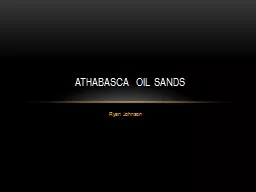

Where are the athabasca oil sands Northeast Alberta Canada Whats So Significant 18 trillion bbl of resources in northeast Alberta 1 trillion bbl contained in Athabasca oil sands ID: 911178
Download Presentation The PPT/PDF document "Ryan Johnson Athabasca Oil Sands" is the property of its rightful owner. Permission is granted to download and print the materials on this web site for personal, non-commercial use only, and to display it on your personal computer provided you do not modify the materials and that you retain all copyright notices contained in the materials. By downloading content from our website, you accept the terms of this agreement.
Slide1
Ryan Johnson
Athabasca Oil Sands
Slide2Where are the athabasca
oil sands?
Northeast Alberta, Canada
Slide3What’s So Significant?
1.8 trillion
bbl
of resources in northeast Alberta
1 trillion
bbl
contained in Athabasca oil sands
Located at outcrop level or shallow depth
Location known from direct observation prior to Geological Survey of Canada descriptions
1875
Tar pits
Slide4What’s the problem?
Petroleum trap is elusive
Trap destroyed due to continued flexural loading
Uplift and erosion
Confusion as to
how
petroleum
was held in place over such a large area
Slide5Approach
Use a
paleohorizon
to examine historical orientation of the layers during charge of oil
Well data (70,000+ well picks)
Identify charge timing of regions of the Athabasca oil sands
Use bitumen-water contact to further confirm orientation of the region
Use kimberlite age dating to correlate with charge timing of oil sands
Was used after study was finished, but good blind test
Slide6History
Western Canada Sedimentary Basin (location of Athabasca oil sands) formation
Precambrian rifting
Paleozoic thermal subsidence along passive margin (western NA)
Megasequences
Paleozoic carbonates, evaporates, and
shales
Exshaw
Formation (source rock)
Late
Mississipian
to Late Jurassic transitional
meagsequence
(subdued subsidence)
Siliciclastic-dominated succession
Gordondale
(source rock)
Slide7History – Megasequences
cont.
Late Jurassic shift to flexural subsidence by Rocky Mountain fold and thrust belt
Siliciclastic-dominated sequence
Mannville
Group (reservoir rock)
McMurray Formation (fluvial-estuarine sands)
Wabiskaw
Member (marine sands)
Capped by Clearwater Formation (shale)
Marine transgression
Overlain by Colorado Group (marine sediments) at Athabasca oil sands
Continuation of flexural subsidence through early Eocene
Slide8History
Slide9Petroleum formation
Source maturity peak at Late Cretaceous
Flexural loading led to maximum burial
Migration of oil hundreds of kilometers from west to east
Petroleum contained mostly in
Mannville
Group
Athabasca oil sands too shallow to pasteurize
Never exceeded 45°C
Biodegradation to bitumen
Coeval charge and biodegradation
Formation of bitumen before tilting
Slide10Reconstruction of trap
Colorado Formation
u
sed for reconstructionFormed around 84 Ma
Presence of a major four-way anticline in central Athabasca area
285 km x 175 km
60 m amplitude (240-300 m depth)
Primary structural trap in Athabasca area
In addition to coeval charge and biodegradation, bitumen distribution controlled by structural and stratigraphic trap elements
Slide11Slide12Trap domains
Athabasca area split into 6 distinct domains
Central Athabasca (structural trap)
44% of Athabasca oil sands by area
300 m closure
Northeastern Athabasca (
onlap
trap)
Shallowest trap edge (200m or less)
270 m lower limit
Tarry bitumen outliers
Leakage at pinch-out
Slide13Trap Domains Cont.
Northern Athabasca (bitumen trap)
Below 270 m
Late charge of oil contained by bitumen already emplaced
Other bitumen traps
Southern & Southwestern Athabasca, and
Wabasca
Below 300 m
spillpoint
Also represent late charge of oil
Slide14Trap domains
Slide15Bitumen-water contact
Defines contact line between bitumen and water separation due to density differences
Local variations in each trap domain
Conforms with
paleostructure
reconstruction
Differences in elevation back interpretations of charge order
Central filled first
Northeastern
onlap
trap second
Followed by deeper peripheral bitumen traps
Slide16Restored
Paleostructure
Slide17Kimberlite
Numerous Late Cretaceous and Paleocene kimberlite pipes
Radiometric dating have been determined
Spatial and temporal relationship to bitumen
3 drill holes with bitumen
“Soaked” in bitumen
Petroleum charge after intrusion of kimberlites
Age dated at 78-70 Ma
2 at almost exactly 300 m closing contour
1 at 334 m (northern trap domain)
Reinforces 84 Ma charge of anticline
Northern trap charged no earlier than 78 Ma
Slide18Kimberlite Pipe
Slide19Conclusion of events
1. Filling of the Central Athabasca four-way anticline (84 Ma)
Coeval charge and biodegradation led to impermeable bitumen (no gas cap)
2. Filling of Northeastern Athabasca
onlap
trap
Shallowest and first to fill after
spillpoint
of the anticline was breached
Shallow depth also led to gas accumulation
3. Filling of peripheral bitumen traps (No earlier than 78 Ma in north)
Updip
bitumen seal
4. Erosion from Eocene to present
Preservation of trap due to rapid rate of biodegradation to bitumen
Tarry bitumen leaks onto surface where erosion has reached the reservoir and at
onlap
edge
Slide20Conclusion of events